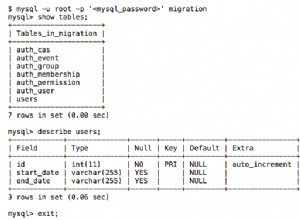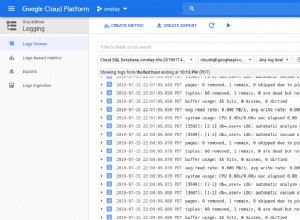CTE_Users ci fornisce l'elenco di tutti gli utenti con le date di inizio e fine per ogni utente.
È unito al Calendar tabella per generare una riga per ogni data per ogni utente.
Infine viene lasciato unito alla tabella principale Test per restituire Total per ogni data. ISNULL assicura che le date che non hanno dati restituiscano 0.
WITH
CTE_Users
AS
(
SELECT
Userid
,MIN(startdate) AS StartDate
,MAX(enddate) AS EndDate
FROM TEST
GROUP BY Userid
)
SELECT
ROW_NUMBER() OVER (ORDER BY CTE_Users.Userid, Calendar.dt) AS ID
,CTE_Users.Userid
,T.Id1
,Calendar.dt
,ISNULL(T.Total, 0) AS Total
FROM
CTE_Users
INNER JOIN Calendar ON
Calendar.dt >= CTE_Users.StartDate
AND Calendar.dt <= CTE_Users.EndDate
LEFT JOIN TEST AS T ON
T.Userid = CTE_Users.Userid
AND T.date1 = Calendar.dt
ORDER BY CTE_Users.Userid, Calendar.dt;
Risultato
| ID | Userid | Id1 | dt | Total |
|----|--------|--------|------------|-------|
| 1 | abc | 1 | 2015-01-13 | 200 |
| 2 | abc | 2 | 2015-01-14 | 200 |
| 3 | abc | 3 | 2015-01-15 | 200 |
| 4 | abc | (null) | 2015-01-16 | 0 |
| 5 | abc | (null) | 2015-01-17 | 0 |
| 6 | abc | (null) | 2015-01-18 | 0 |
| 7 | abc | 4 | 2015-01-19 | 200 |
| 8 | abc | 5 | 2015-01-20 | 200 |
| 9 | abc | (null) | 2015-01-21 | 0 |
| 10 | abc | (null) | 2015-01-22 | 0 |
| 11 | abc | 6 | 2015-01-23 | 200 |
| 12 | abc | 7 | 2015-01-24 | 200 |
| 13 | def | (null) | 2015-02-10 | 0 |
| 14 | def | (null) | 2015-02-11 | 0 |
| 15 | def | 8 | 2015-02-12 | 200 |
| 16 | def | 9 | 2015-02-13 | 200 |
| 17 | def | (null) | 2015-02-14 | 0 |
| 18 | def | 10 | 2015-02-15 | 200 |
| 19 | def | 11 | 2015-02-16 | 200 |
| 20 | def | 12 | 2015-02-17 | 200 |
| 21 | def | 13 | 2015-02-18 | 200 |
| 22 | def | (null) | 2015-02-19 | 0 |
| 23 | def | (null) | 2015-02-20 | 0 |
ID è un numero di riga generato al volo.Id1 è l'ID originale del Test tavolo.
Genererei Calendar tabella come questa:
CREATE TABLE [Calendar](
[dt] [date] NOT NULL
CONSTRAINT [PK_Calendar] PRIMARY KEY CLUSTERED
(
[dt] ASC
));
-- 10K dates from 2000-01-01 till 2027-05-18
INSERT INTO Calendar (dt)
SELECT TOP (10000)
DATEADD(day, ROW_NUMBER() OVER (ORDER BY s1.[object_id])-1, '2000-01-01') AS dt
FROM sys.all_objects AS s1 CROSS JOIN sys.all_objects AS s2
OPTION (MAXDOP 1);




